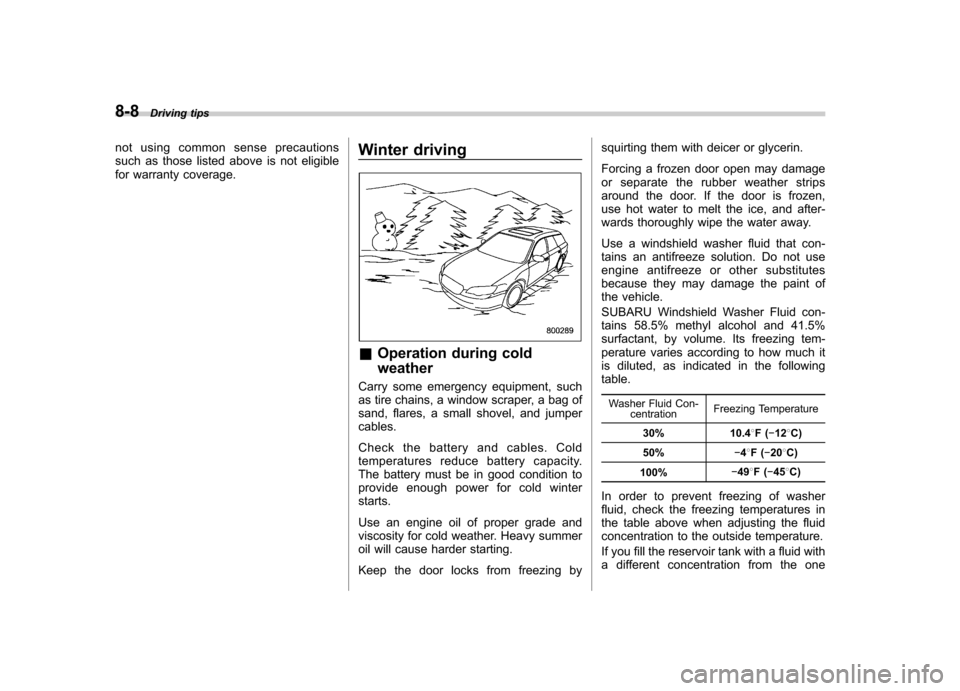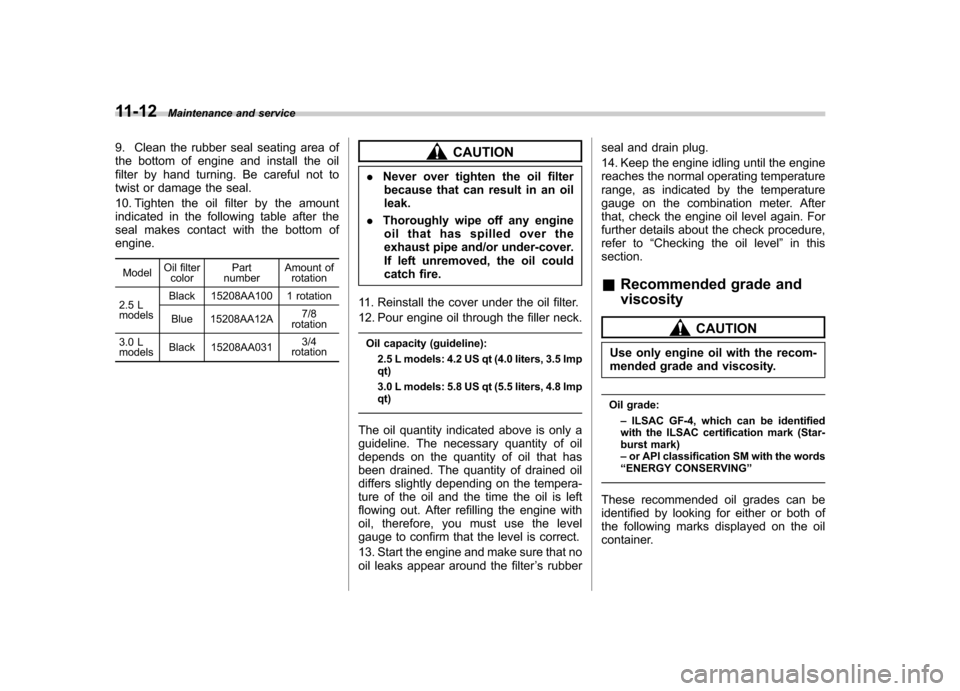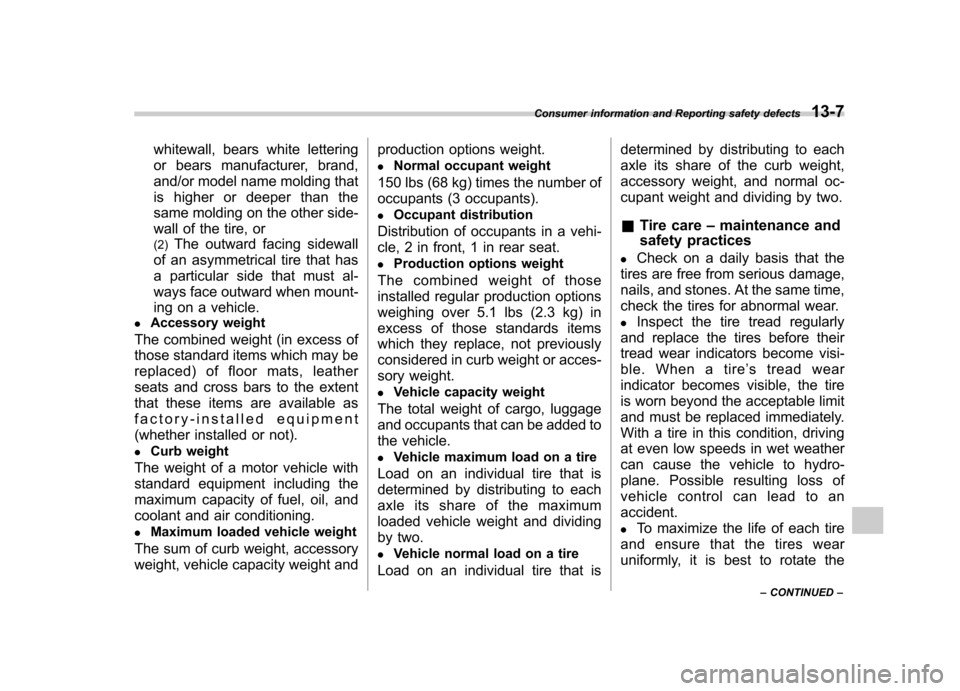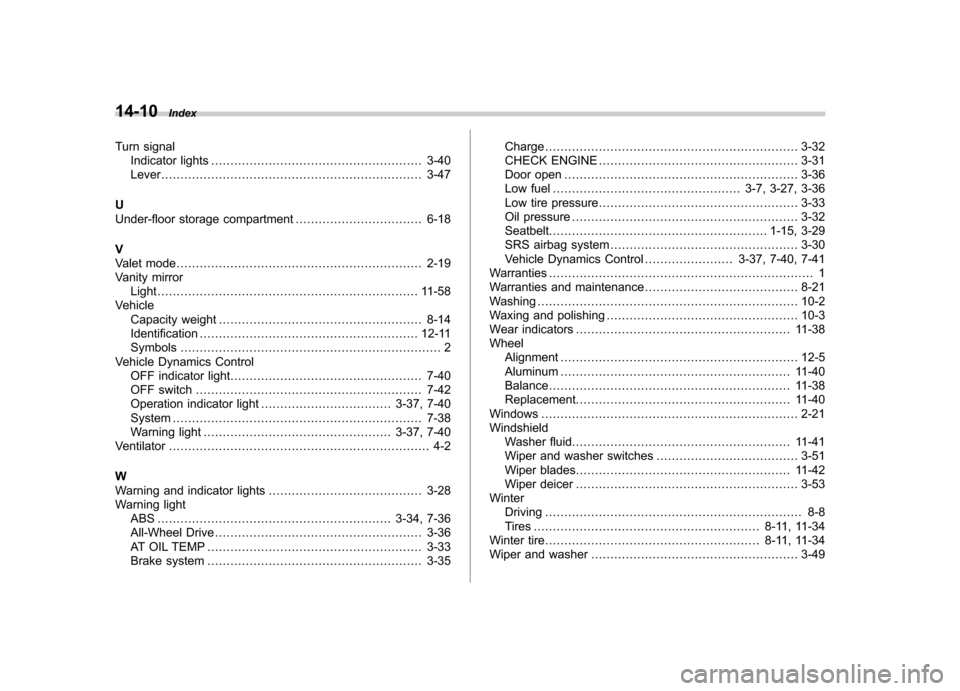2009 SUBARU OUTBACK oil capacity
[x] Cancel search: oil capacityPage 304 of 447

8-8Driving tips
not using common sense precautions
such as those listed above is not eligible
for warranty coverage. Winter driving
&
Operation during cold weather
Carry some emergency equipment, such
as tire chains, a window scraper, a bag of
sand, flares, a small shovel, and jumpercables.
Check the battery and cables. Cold
temperatures reduce battery capacity.
The battery must be in good condition to
provide enough power for cold winterstarts.
Use an engine oil of proper grade and
viscosity for cold weather. Heavy summer
oil will cause harder starting.
Keep the door locks from freezing by squirting them with deicer or glycerin.
Forcing a frozen door open may damage
or separate the rubber weather strips
around the door. If the door is frozen,
use hot water to melt the ice, and after-
wards thoroughly wipe the water away.
Use a windshield washer fluid that con-
tains an antifreeze solution. Do not use
engine antifreeze or other substitutes
because they may damage the paint of
the vehicle.
SUBARU Windshield Washer Fluid con-
tains 58.5% methyl alcohol and 41.5%
surfactant, by volume. Its freezing tem-
perature varies according to how much it
is diluted, as indicated in the followingtable.
Washer Fluid Con- centration Freezing Temperature
30% 10.4 8F( �12 8C)
50% �48F( �20 8C)
100% �
49 8F( �45 8C)
In order to prevent freezing of washer
fluid, check the freezing temperatures in
the table above when adjusting the fluid
concentration to the outside temperature.
If you fill the reservoir tank with a fluid with
a different concentration from the one
Page 362 of 447

11-12Maintenance and service
9. Clean the rubber seal seating area of
the bottom of engine and install the oil
filter by hand turning. Be careful not to
twist or damage the seal.
10. Tighten the oil filter by the amount
indicated in the following table after the
seal makes contact with the bottom ofengine.
Model Oil filter
color Part
number Amount of
rotation
2.5 L models Black 15208AA100 1 rotation
Blue 15208AA12A 7/8
rotation
3.0 L models Black 15208AA031 3/4
rotationCAUTION
. Never over tighten the oil filter
because that can result in an oil leak.
. Thoroughly wipe off any engine
oil that has spilled over the
exhaust pipe and/or under-cover.
If left unremoved, the oil could
catch fire.
11. Reinstall the cover under the oil filter.
12. Pour engine oil through the filler neck. Oil capacity (guideline): 2.5 L models: 4.2 US qt (4.0 liters, 3.5 Imp qt)
3.0 L models: 5.8 US qt (5.5 liters, 4.8 Imp qt)
The oil quantity indicated above is only a
guideline. The necessary quantity of oil
depends on the quantity of oil that has
been drained. The quantity of drained oil
differs slightly depending on the tempera-
ture of the oil and the time the oil is left
flowing out. After refilling the engine with
oil, therefore, you must use the level
gauge to confirm that the level is correct.
13. Start the engine and make sure that no
oil leaks appear around the filter ’s rubber seal and drain plug.
14. Keep the engine idling until the engine
reaches the normal operating temperature
range, as indicated by the temperature
gauge on the combination meter. After
that, check the engine oil level again. For
further details about the check procedure,
refer to
“Checking the oil level ”in this
section. & Recommended grade and viscosity
CAUTION
Use only engine oil with the recom-
mended grade and viscosity.
Oil grade: –ILSAC GF-4, which can be identified
with the ILSAC certification mark (Star-
burst mark) – or API classification SM with the words
“ ENERGY CONSERVING ”
These recommended oil grades can be
identified by looking for either or both of
the following marks displayed on the oil
container.
Page 427 of 447

whitewall, bears white lettering
or bears manufacturer, brand,
and/or model name molding that
is higher or deeper than the
same molding on the other side-
wall of the tire, or (2)The outward facing sidewall
of an asymmetrical tire that has
a particular side that must al-
ways face outward when mount-
ing on a vehicle.
. Accessory weight
The combined weight (in excess of
those standard items which may be
replaced) of floor mats, leather
seats and cross bars to the extent
that these items are available as
factory-installed equipment
(whether installed or not). . Curb weight
The weight of a motor vehicle with
standard equipment including the
maximum capacity of fuel, oil, and
coolant and air conditioning. . Maximum loaded vehicle weight
The sum of curb weight, accessory
weight, vehicle capacity weight and production options weight.
. Normal occupant weight
150 lbs (68 kg) times the number of
occupants (3 occupants). . Occupant distribution
Distribution of occupants in a vehi-
cle, 2 in front, 1 in rear seat.. Production options weight
The combined weight of those
installed regular production options
weighing over 5.1 lbs (2.3 kg) in
excess of those standards items
which they replace, not previously
considered in curb weight or acces-
sory weight. . Vehicle capacity weight
The total weight of cargo, luggage
and occupants that can be added to
the vehicle. . Vehicle maximum load on a tire
Load on an individual tire that is
determined by distributing to each
axle its share of the maximum
loaded vehicle weight and dividing
by two. . Vehicle normal load on a tire
Load on an individual tire that is determined by distributing to each
axle its share of the curb weight,
accessory weight, and normal oc-
cupant weight and dividing by two. &
Tire care –maintenance and
safety practices
. Check on a daily basis that the
tires are free from serious damage,
nails, and stones. At the same time,
check the tires for abnormal wear.. Inspect the tire tread regularly
and replace the tires before their
tread wear indicators become visi-
ble. When a tire ’s tread wear
indicator becomes visible, the tire
is worn beyond the acceptable limit
and must be replaced immediately.
With a tire in this condition, driving
at even low speeds in wet weather
can cause the vehicle to hydro-
plane. Possible resulting loss of
vehicle control can lead to anaccident. . To maximize the life of each tire
and ensure that the tires wear
uniformly, it is best to rotate the
Consumer information and Reporting safety defects
13-7
– CONTINUED –
Page 444 of 447

14-10Index
Turn signal Indicator lights ....................................................... 3-40
Lever .................................................................... 3-47
U
Under-floor storage compartment ................................. 6-18
V
Valet mode ................................................................ 2-19
Vanity mirror Light .................................................................... 11-58
Vehicle Capacity weight ..................................................... 8-14
Identification ......................................................... 12-11
Symbols .................................................................... 2
Vehicle Dynamics Control
OFF indicator light .................................................. 7-40
OFF switch ........................................................... 7-42
Operation indicator light .................................. 3-37, 7-40
System ................................................................. 7-38
Warning light ................................................. 3-37, 7-40
Ventilator .................................................................... 4-2
W
Warning and indicator lights ........................................ 3-28
Warning light
ABS ............................................................. 3-34, 7-36
All-Wheel Drive ...................................................... 3-36
AT OIL TEMP ........................................................ 3-33
Brake system ........................................................ 3-35 Charge
.................................................................. 3-32
CHECK ENGINE .................................................... 3-31
Door open ............................................................. 3-36
Low fuel ................................................. 3-7, 3-27, 3-36
Low tire pressure .................................................... 3-33
Oil pressure ........................................................... 3-32
Seatbelt. ........................................................ 1-15, 3-29
SRS airbag system ................................................. 3-30
Vehicle Dynamics Control ....................... 3-37, 7-40, 7-41
Warranties ..................................................................... 1
Warranties and maintenance ........................................ 8-21
Washing .................................................................... 10-2
Waxing and polishing .................................................. 10-3
Wear indicators ........................................................ 11-38
Wheel Alignment .............................................................. 12-5
Aluminum ............................................................ 11-40
Balance ............................................................... 11-38
Replacement. ....................................................... 11-40
Windows ................................................................... 2-21
Windshield
Washer fluid. ........................................................ 11-41
Wiper and washer switches ..................................... 3-51
Wiper blades ........................................................ 11-42
Wiper deicer .......................................................... 3-53
Winter Driving ................................................................... 8-8
Tires ........................................................... 8-11, 11-34
Winter tire ........................................................ 8-11, 11-34
Wiper and washer ...................................................... 3-49
Page 446 of 447

GAS STATION REFERENCE
& Fuel:
! 2.5 L non-turbo models
Use only unleaded gasoline with an octane rating of 87 AKI or
higher .
! 2.5 L turbo models
Use premium unleaded gasoline with an octane rating of 91
AKI or higher . For temporary purposes if premium unleaded
gasoline is not available, you may use regular unleaded
gasoline with an octane rating of 87 AKI or higher. For optimum
engine performance and driveability, it is required that you use
premium grade unleaded gasoline. ! 3.0 L models
Use unleaded gasoline with an octane rating of 91 AKI or
higher . Regular unleaded gasoline with an octane rating of 87
AKI or higher may be used. However for optimum engine
performance and driveability, it is recommended that you use
91 AKI or higher grade unleaded gasoline. You may experience
reduced output, poor accelerator response, and reduced fuel
economy when using gasoline with an octane rating lower than
91 AKI, depending on your driving habits and conditions. If you
experience any of these conditions while using a lower octane
rated fuel, you may want to return to using 91 AKI octane rated
fuel as soon as possible. Additionally, if your vehicle knocks
heavily or persistently, or if you are driving with heavy loads
such as when towing a trailer, the use of 91 AKI or higher grade
unleaded gasoline is required. &
Fuel octane rating
This octane rating is the average of the Research Octane and
Motor Octane numbers and is commonly referred to as the Anti
Knock Index (AKI). Refer to “Fuel ”section in this manual.
& Fuel capacity:
16.9 US gal (64 liters, 14.1 Imp gal) & Engine oil:
Use only API classification SM with the words “ENERGY
CONSERVING ”or ILSAC GF-4, which can be identified with
the ILSAC certification mark (Starburst mark).& Engine oil capacity:
2.5 L models: 4.2 US qt (4.0 liters, 3.5 Imp qt)
3.0 L models: 5.8 US qt (5.5 liters, 4.8 Imp qt)